The Nasdaq-100 Trust ETF, ticker symbol QQQ, is both one of the most loved and most hated ETFs in the US market. Investors who bought and held $10,000 worth 15 years ago on September 10, 2009 have every reason to love it. They now have seen that investment grow to $126,000, an annualized gain of 18.4%. Very few non-leveraged ETFs could even approach this growth, especially considering that less than 20% of the US ETFs that are traded today even existed in 2009. In contrast, SPY, the S&P 500 Trust managed by SSgA SPDRs, has grown by an annualized 13.8% during the same period.
All 5,000 stocks, 16 sector groups, 140 industries, and 500 ETFs have been updated:
Two-week free trial: www.ValuEngine.com
This table, courtesy of FinanceCharts.com, shows that the performance of QQQ dominated other benchmark ETFs during the past five- and ten- year periods on a cumulative basis – as distinct from compound annualized.
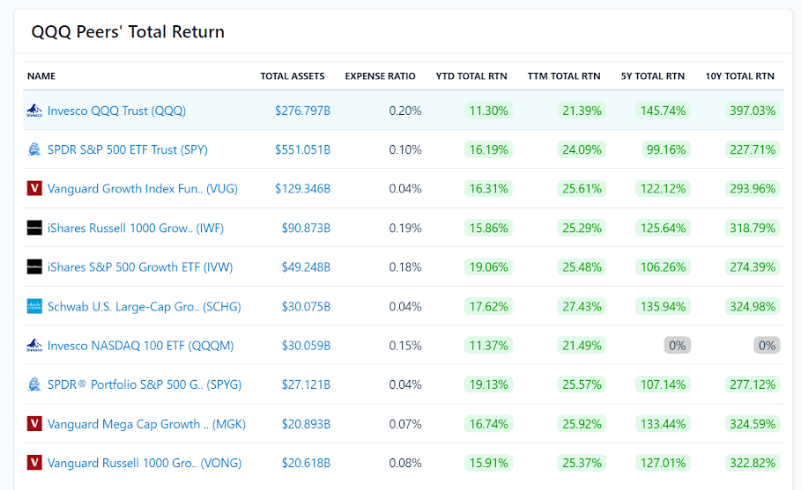
That growth rate is still quite impressive and higher than more than 80% of actively managed mutual funds with large cap core mandates. Why is QQQ hated?
Most strategists believe it is grossly overvalued and near the top of its cycle. It’s considered a 15-year bubble that is about to burst. Many professionals recommend at least partial divestment at this time. Two major reasons are correlation and concentration. Out of its 100 holdings, the ten largest holdings of QQQ constitute 49.8%, roughly half, of its portfolio. Of those ten, only Costco Wholesale (COST) is not a tech stock.
Current ValuEngine reports on all covered stocks and ETFS can be viewed HERE
From the ValuEngine report page on QQQ, here are the holdings and some context:
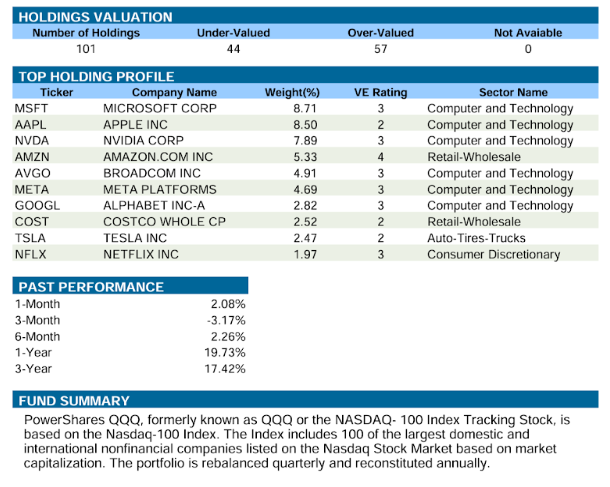
Overall, ValuEngine classifies 61.6% of the portfolio’s holdings as being in the technology sector. In contrast, the top 10 positions of Invesco equally weighted S&P 500 ETF (RSP) was only 2.2% of the full portfolio. However, concentration is far from the only risk.
That said, ValuEngine is not nearly as convinced as QQQ’s vocal critics that now is the time to trim or sell. Our predictive model rates it a buy, giving it 4 out of a possible 5, in comparison with a 3 (Hold) for RSP.
From the perspective of our valuation model, about 44% of its holdings are undervalued and 56% are overvalued. That tips it towards over-valued but not by any more than the market as a whole, and not unusual. In contrast, the same model rates more than 70% of companies in SPY (and RSP with identical holdings) as overvalued and our predictive model rates it a 3 (Hold). That said, the only one of the top 10 holdings of QQQ to earn a buy rating as an individual stock is Amazon Corp. (AMZN).
Market pricing tends to be future oriented and growth stocks fetch more of a fair-value premium than value stocks. This is especially true if value is being measured by backward-looking ratios such as Price/Earnings. At some time, however, today’s growth stocks become tomorrow’s value stocks as the company inevitably progresses from its growth phase into its value stage. Such maturing stocks will eventually be repriced by the market. Many of the aforementioned strategists suggest that rather than take such risks, investors reducing QQQ positions should buy active or passive value ETFs instead.
I personally find this a bit of a leap. In addition to the fact that our research and models still finds QQQ attractive, “one size fits all” never applies to the clients of money managers. Specifically, a client that has been holding QQQ likely has capital appreciation over income and/or capital preservation as the top goal for her or his portfolio. If so, moving dollars out of QQQ and into a US value ETF such as the Vanguard Value ETF (VTV) may not result in the desired results for the client.
Growth related to technology investing is generally a function of innovation. Stocks currently in QQQ will eventually leave the portfolio to be replaced by new leaders, such as the recent examples of NVDIA Corp. (NVDA) and Broadcom (AVGO). They were both midcap stocks on the Nasdaq Exchange before they became titans. In other words, the true potential for capital appreciation in technology for growth investors is identifying the tech leaders of tomorrow that will be included in the Nasdaq-100 in the future. This perhaps can offer better growth than buying the companies already known to be the current tech leaders.
For investors trying to identify these future leaders, Nasdaq and Invesco have teamed up to create two index-based ETFs with the tickers QQQJ and QQQS.
QQQJ is the ticker symbol for the Nasdaq Next Gen 100 ETF. This index ETF contains the largest 100 non-financial Nasdaq-listed companies that are not in the Nasdaq 100. Another way to think about it is that this constituent list is #101 through #200 of qualifying stocks as ranked by float-weighted market capitalization. The idea behind the fund is that the Nasdaq-listed companies in QQQJ may be mid-cap stocks early in their growth cycle with the potential to “graduate” to the Nasdaq-100 Index and lead the next generation of tech leaders. One potential benefit is that It offers a liquid way to get exposure to leading mid-cap growth stocks without single stock risk. In contrast, the assets-under-management (AUM) leader accessing a portfolio of midcap stocks is the S&P 400 Midcap Trust (MDY) offered by SPDRs. However, that ETF contains a number of regional banks and utilities that are not growth stocks. QQQJ contains neither banks nor utilities. Its annual expense ratio is just 0.15% making it one of the least expensive ETFs in its category.
QQQJ debuted in October 2020. By the end of next month, it will have four full years of historical performance. So far, the results have been mixed. Its returns during that period have badly lagged those of QQQ and SPY. Here are some insights from the ValuEngine research report.
Current ValuEngine reports on all covered stocks and ETFS can be viewed HERE
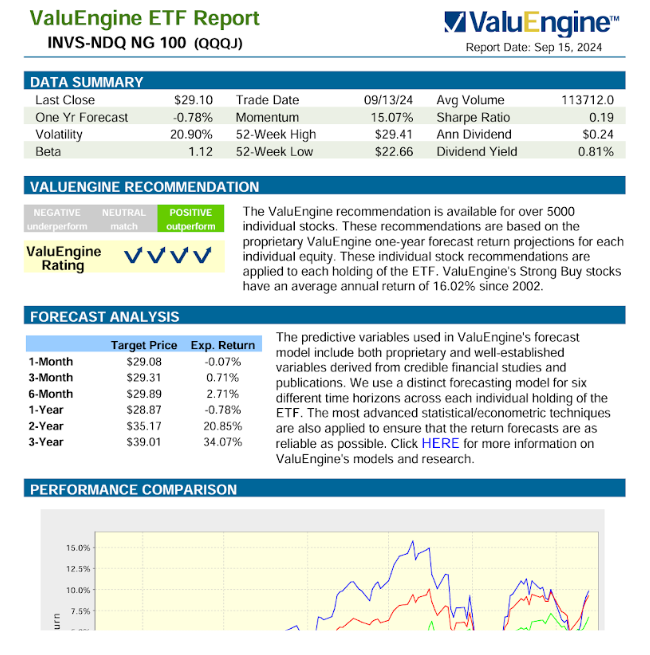
QQQJ is currently rated a 4 (Buy) by our predictive ranking system. Its Beta of 1.12 is surprisingly low for a midcap tech portfolio. The second page of this report provides more ratios as well as important data about its holdings.
Current ValuEngine reports on all covered stocks and ETFS can be viewed HERE
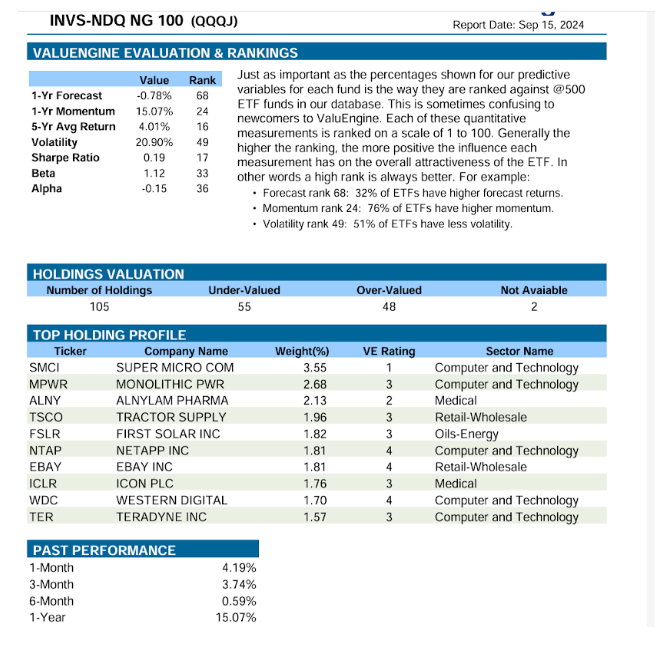
Interestingly and somewhat counterintuitively, more than half of the stocks in QQQJ are classified as undervalued by the ValuEngine valuation model. Veteran investors such as myself generally think of midcap tech stocks as having relatively high valuations but our model indicated that is not the case here. In terms of top 10 holdings, there are three stocks rated 4 (Buy) by our predictive model: NetApp Inc. (NTAP); eBay (EBAY); and Western Digital (WDC). At the other end of the spectrum, the top holding and representing 3.5% of QQQJ, is Super Micro Com (SMCI), a “fallen angel” with a 6-month return of -57% that may still be falling. We rate it a 1 (Strong Sell).
The Invesco NASDAQ Future Gen 200 ETF (QQQS) is an even more recent innovation, having just finished 12 months of live performance. On paper, its design is quite intriguing. QQQS provides access to small-cap companies with promising patent portfolios relative to their total market value as deemed by Nasdaq.
The theory is that valuable patents help companies to gain competitive advantages and garner likely revenue growth. QQQS will invest at least 90% of its total assets in the securities that comprise the index. Healthcare (55.65%) and Information Technology (30.51%) are the top two sectors of the fund.
The fund holds about 199 stocks in total. The eligible universe consists of the companies within the Nasdaq Composite Index, barring those companies included on the Nasdaq-100 Index and Nasdaq Next Generation 100 Index. Each constituent within the index is equally weighted. The fund charges just 20 bps in fees, again highly competitive in the small cap technology space. No stock may account for more than 2% of the fund.
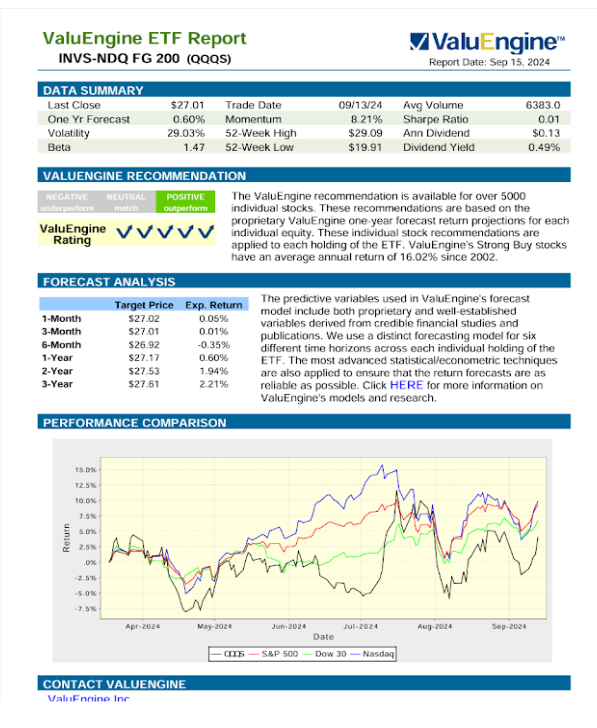
The above screenshot from the ValuEngine page illustrates that its price behavior thus far has paralleled that of QQQ but has underperformed it significantly. This is unsurprising given the large cap tech stock dominance during the first half of this year. Its Beta is 2.47 making it much more volatile than QQQJ. In terms of predicted performance, our model likes QQQS even more than QQQJ with our highest rating of 5 (Strong Buy).
Here’s a thought-provoking idea on how an investor might use QQQS from a research note by Sanghamitra Saha of Zacks.
“Apart from competitive advantages in the same business, a strategic patent portfolio improves valuation of the company and puts that company in an advantageous position during M&A deals. Higher revenues generated from those patents also make up for the high R&D costs incurred by those companies in building those patents.
In the current economic doldrums created by high supply-chain-induced inflation and rising rates, exposure to quality companies is warranted. The broader market is sharply down this year and may remain subdued next year if the Fed continues to hike rates and the economy tips into a recession.
Rising rates are negative for growth sectors like technology and biotech. The fund QQQS is highly-focused on these two sectors. Investors should note that only high-quality tech and biotech companies are likely to sail through in the current environment. Small-cap stocks appear even better bets as these are domestically-focused and do not get hurt by a rising greenback.”
These rationales are exactly what led me to feature these ETFs today. Ms. Saha’s note expressed it so eloquently and concisely that I decided to include so much of it here.
Consistent with its ValuEngine rating, four of the 10 largest stock holdings of QQQS are rated 5 (Strong Buy) or 4 (Buy). The 5-rated stocks (strong buy) are American Semiconductor (AMSC), a Massachusetts based power-resiliency solution provider and Silk Road Medical, a medical device company headquartered in Sunnyvale, CA. The 4-rated stocks represent Microvast Holdings (MVST), a Texas-based battery technologies company and Amkor Tech, an Arizona-based semiconductor and packaging company.
Financial Advisory Services based on ValuEngine research available: www.ValuEngineCapital.com
Given the fact that QQQS selects small-cap companies based on patent portfolios, I found its expense ratio of 0.20% (20 basis points) to be surprisingly modest. In contrast, the Invesco Small Cap Technology Index ETF (PSCT), also an Invesco product, has an expense ratio of 0.29% (reduced from 0.40% just last year) with no value-added research and less than half as many holdings, while just matching a cap weighted index of the technology companies in the S&P Small Cap 600 Index. The number of companies combined with cap-weighting makes quite a difference in diversification. The top 10 holdings of PSCT comprise 35% of its portfolio as compared with 9% for the analogous calculation applied to QQQS.
While on the subject of fees, another Invesco ETF on a Nasdaq, the Invesco Nasdaq 100 ETF QQQM (QQQ has the word Trust in its title rather than ETF indicating a less-efficient legacy structure), is worthy of mention. Its advantages combine a structure that is more efficient because it can lend securities and reinvest dividends along with a fee of 0.15%. That is 25% lower than the 0.20% charged for QQQ. When you buy new shares of QQQM, you hold the exact same portfolio as QQQ but it’s cheaper and more efficient. My advice for those looking to add to or establish a new QQQ position to do so with QQQM unless you are trading more than 500,000 shares and need institutional liquidity. As is also true with the SPDR S&P 500 ETF (SPLG, 2 basis points) vs. the SPDR S&P 500 Trust (SPY, 9.5 basis points and less efficient). In the ETF world, you can actually pay more and get less.
______________________________________________________________
By Herbert Blank
Senior Quantitative Analyst, ValuEngine Inc
www.ValuEngine.com
support@ValuEngine.com
All of the over 5,000 stocks, 16 sector groups, over 250 industries, and 600 ETFs have been updated on www.ValuEngine.com
Financial Advisory Services based on ValuEngine research available through ValuEngine Capital Management, LLC
Free Two-Week Trial to all 5,000 plus equities covered by ValuEngine HERE
Subscribers log in HERE
